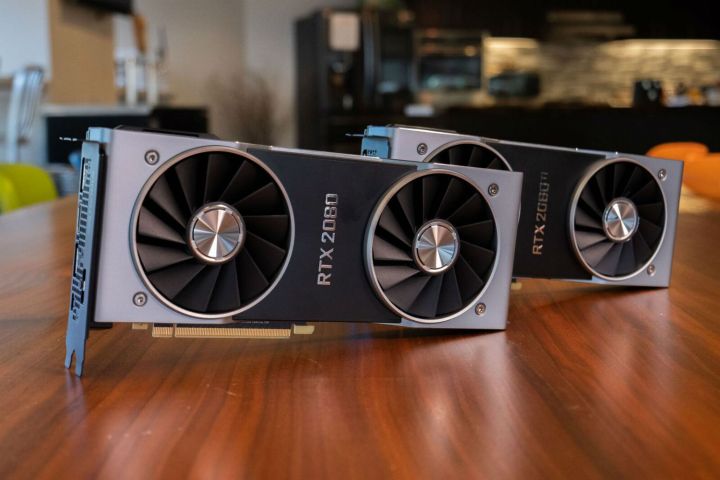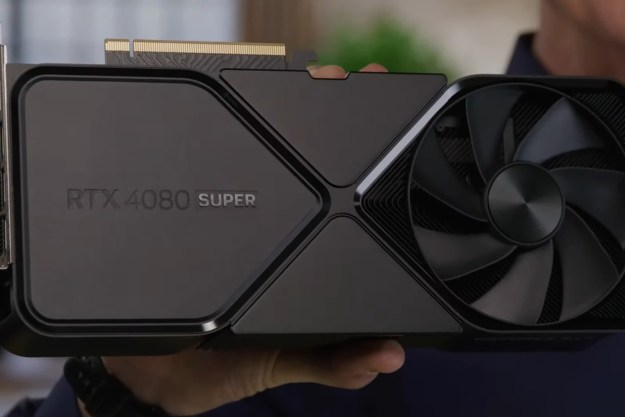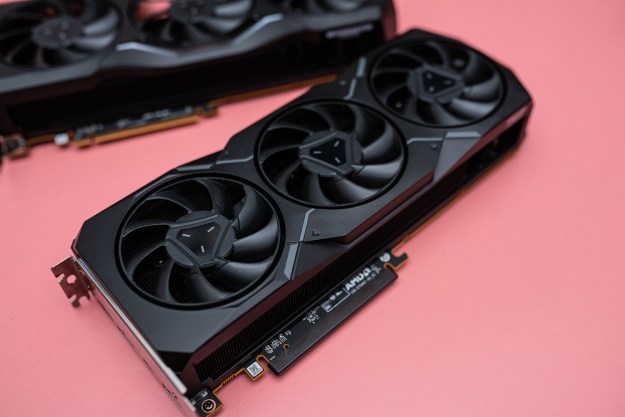Nvidia’s tease and then release of its RTX Super graphics cards was a clear response (and attempt to disrupt) AMD’s RX 5000-series GPUs. It’s difficult to tell whether it was successful, but the end result is a much more competitive environment for graphics cards in the mid to high-end of the price to performance spectrum. In late 2019, there are a number of Super and non-super cards available from the green team, and potentially new GTX Super cards incoming before the end of the year.
Pricing and availability
The original line of RTX Super graphics cards made their debut on July 9, 2019, with the RTX 2060 Super, and RTX 2070 Super. They were followed by the high-end RTX 2080 Super on July 23. Their pricing effectively supplanted existing non-Super RTX graphics cards, by bumping those older designs down the price to performance rankings, as their relative power dictated.
| Graphics card | Price |
| RTX 2080 Super | $800 |
| RTX 2080 | $700 |
| RTX 2070 Super | $600 |
| RTX 2070 | $500 |
| RTX 2060 Super | $430 |
| RTX 2060 | $350 |
Since their release, prices for these cards have fluctuated and become broader, thanks to third-party variants offering greater variety to buyers. The RTX 2060 Super varies between $400 and $470. The RTX 2070 Super can cost up to $590 for the prettiest and most overclocked versions. The RTX 2080 Super can be found for noticeably cheaper, with some priced at just $720, though watercooled versions and more capable options can cost close to $900.
These prices are competitive with AMD’s RX 5700 and 5700 XT and Nvidia has plans for the upcoming RX 5500 and RX 5500m. That’s where the rumored GTX 1660 Super and GTX 1650 Super come in. Nvidia has yet to officially announce them (and there is some debate over whether it will be a 1650 Ti, or 1650 Super) but early leaks and rumors suggest they will launch on October 29 and November 22, respectively. The GTX 1660 Super is expected to cost $229 at launch, although that puts it very close to the 1660 Ti. The 1650 Super is expected to cost around $180.
Performance

The RTX Super graphics cards fit neatly between their respective non-Super variants and performance plays out like you might expect. Leaked specifications for the GTX 16-series Super
| RTX 2060 | RTX 2060 Super | RTX 2070 | RTX 2070 Super | RTX 2080 | RTX 2080 Super | RTX 2080 Ti | |
| GPU | TU106-200 | TU106-410 | TU106-400 | TU104-410 | TU104-400 | TU104-450 | TU102-300A |
| CUDA Cores | 1,920 | 2,176 | 2,304 | 2,560 | 2,944 | 3,072 | 4,352 |
| Base clock | 1,365MHz | 1,407MHz | 1,410MHz | 1,605MHz | 1,515MHz | 1,650MHz | 1,350MHz |
| Boost clock | 1,680MHz | 1,650MHz | 1,620MHz | 1,770MHz | 1,710MHz | 1,815MHz | 1,545MHz |
| RT Cores | 30 | 34 | 36 | 40 | 46 | 48 | 68 |
| Tensor Cores | 240 | 272 | 288 | 320 | 368 | 384 | 544 |
| Memory | 6GB GDDR6 | 8GB GDDR6 | 8GB GDDR6 | 8GB GDDR6 | 8GB GDDR6 | 8GB GDDR6 | 11GB |
| Memory Speed | 14Gbps | 14Gbps | 14Gbps | 14Gbps | 14Gbps | 15.5Gbps | 14Gbps |
| TDP | 160w | 175w | 175w | 215w | 215w | 250w | 250w |
Most of the new Super cards use slightly weaker versions of the GPU from one stack up. The RTX 2060 super is built on a stripped-back version of the RTX 2070’s GPU, rather than an improved variant of the 2060. The 2070 Super borrows a cut-down 2080 GPU. The only outlier there is the 2080 Super, which has a brand new GPU to call its own.
All Duper cards feature a greater number of CUDA cores than their non-Super counterparts, and clock speeds have gone up across the board — most notably when it comes to base frequencies, which guarantee a higher performance floor for the newer cards. The RTX 2070 Super’s memory stayed the same, but the RTX 2080 Super has faster memory, while the 2060 Super has been upgraded to the same 8GB of GDDR6 found on the other, more capable RTX GPUs.
All of this resulted in some impressive performance gains for the new Nvidia Super cards. In our review we found that they are certainly the more viable GPUs in their range, with the RTX 2070 Super being particularly noteworthy for how close it is in performance to the more expensive RTX 2080. They also proved hotly competitive with AMD’s RX 5700 and 5700 XT, with the RTX 2060 Super and 2070 offering comparable performance, at a slightly inflated price.
GTX Super cards
We don’t have much in the way of benchmarks for the upcoming GTX Super cards, but there have been some leaked specifications which suggest they will fill the slim gaps that exist in Nvidia’s current lineup of GTX 16-series graphics cards.
| GTX 1650 | GTX 1650 Super | GTX 1660 | GTX 1660 Super | GTX 1660 Ti | |
| GPU | TU117-300 | TU117 | TU116-300 | TU116-300 | TU116-400 |
| CUDA Cores | 896 | 1,280 | 1,408 | 1,408 | 1,536 |
| Base Clock | 1,485MHz | 1,530MHz | 1,530MHz | 1,530MHz | 1,500MHz |
| Boost Clock | 1,665MHz | 1,725MHz | 1,785MHz | 1,785MHz | 1,770MHz |
| Memory | 4GB GDDR5 | 4GB GDDR6 | 6GB GDDR6 | 6GB GDDR6 | 6GB GDDR6 |
| Memory Speed | 8Gbps | 12Gbps | 8Gbps | 14Gbps | 12Gbps |
| TDP | 75w | 100w | 120w | 125w | 120w |
With the new Super cards, Nvidia is cramming a lot of options into a slim price bracket between $150 and $300, without much to differentiate some of these cards. The 1660 Super specs put it very, very close to the 1660 Ti and it could be faster in certain circumstances thanks to its substantially quicker memory and higher boost clock speed. Especially if overclocked.
We’ll need to test these cards ourselves before giving any kind of judgement on them, but they raise interesting questions about how the 16-series will face off against AMD’s impending RX 5500. With it alleged to have 8GB of GDDR6, these cards may need to be priced extremely competitively to remain relevant. Especially if the new Navi card drives down pricing on existing RX 500 cards.
What about ray tracing?

One of the biggest selling points of Nvidia’s RTX-series of Turing graphics cards was — and still is — support for ray tracing and deep learning super sampling. While those features still aren’t found in more than a handful of games, they do represent an important consideration for potential buyers and the Super versions of those cards do little to change that.
The RTX Super cards are ever-so-slightly better than their non-Super counterparts, with a modicum of additional RT cores (just two in the case of the RTX 2080 Super), which isn’t enough to be noticeable in-game. It does add a little extra value to the new cards, but not enough that they’re worth considering exclusively because of it.
The GTX Super cards don’t have any RT cores to speak of. However, they can technically perform ray tracing operations in game thanks to a driver update from Nvidia in early 2019 that validated all GTX 16 and 10-series cards for the task. That said, only the GTX 1080 and 1080 Ti have shown any real capability at it, and even then, you’d be limited to 1080p if you wanted playable frame rates. We’d suggest leaving ray tracing to RTX cards, unless you just want a quick look at what it may be like to play with the feature.
Editors' Recommendations
- Nvidia RTX 50-series graphics cards: news, release date, price, and more
- 10 best graphics cards of 2024: finding the best GPU for gaming
- CableMod’s adapters damaged up to $74K worth of Nvidia GPUs
- The Nvidia RTX 4080 Super just trounced AMD
- This underrated AMD GPU beats the RTX 4070 Ti Super





